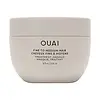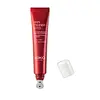What's inside
What's inside
 Key Ingredients
Key Ingredients

 Benefits
Benefits

 Concerns
Concerns

 Ingredients Side-by-side
Ingredients Side-by-side

Water
Skin ConditioningCetearyl Alcohol
EmollientBehentrimonium Chloride
PreservativeCetyl Alcohol
EmollientStearamidopropyl Dimethylamine
EmulsifyingCetyl Esters
EmollientHydrogenated Ethylhexyl Olivate
EmollientAmodimethicone
Isododecane
EmollientJojoba Esters
EmollientGlycerin
HumectantButyrospermum Parkii Butter
Skin ConditioningPanthenol
Skin ConditioningOryza Sativa Bran Oil
EmollientCocos Nucifera Water
MaskingPhyllostachys Bambusoides Juice
Skin ConditioningTamarindus Indica Seed Gum
Emulsion StabilisingLaureth-9
EmulsifyingDaucus Carota Sativa Root Extract
Skin ConditioningHydrolyzed Hibiscus Esculentus Extract
Skin ConditioningJasminum Officinale Flower Extract
MaskingNasturtium Officinale Extract
PerfumingHelianthus Annuus Seed Oil
EmollientZingiber Officinale Root Extract
MaskingAmaranthus Caudatus Seed Extract
Skin ConditioningMoringa Oleifera Seed Extract
Skin ConditioningHydrolyzed Linseed Extract
Skin ConditioningPisum Sativum Extract
Skin ConditioningCynara Scolymus Leaf Extract
Skin ConditioningArginine
MaskingAlanine
MaskingGlycine
BufferingHistidine
HumectantIsoleucine
Skin ConditioningPhenylalanine
MaskingSerine
MaskingValine
MaskingProline
Skin ConditioningThreonine
Aspartic Acid
MaskingLaurdimonium Hydroxypropyl Hydrolyzed Keratin
Skin ConditioningHydrolyzed Rice Protein
Skin ConditioningHydrolyzed Corn Protein
Skin ConditioningHydrolyzed Yeast Protein
Skin ConditioningEthylhexylglycerin
Skin ConditioningPropanediol
SolventPentylene Glycol
Skin ConditioningParfum
MaskingCetrimonium Chloride
AntimicrobialTrideceth-12
EmulsifyingC11-15 Pareth-7
EmulsifyingPolysilicone-15
UV FilterHydrolyzed Vegetable Protein Pg-Propyl Silanetriol
Skin ConditioningCystine Bis-Pg-Propyl Silanetriol
Skin ConditioningSodium PCA
HumectantPCA
HumectantDiisostearyl Malate
EmollientPolysorbate 60
EmulsifyingHydrogenated Olive Oil Unsaponifiables
EmollientLeuconostoc/Radish Root Ferment Filtrate
AntimicrobialSodium Lactate
BufferingGuar Hydroxypropyltrimonium Chloride
Skin ConditioningHydroxyethylcellulose
Emulsion StabilisingBHT
AntioxidantPentaerythrityl Tetra-Di-T-Butyl Hydroxyhydrocinnamate
AntioxidantDisodium EDTA
Disodium Phosphate
BufferingSodium Phosphate
BufferingIsopropyl Alcohol
SolventTocopherol
AntioxidantRosmarinus Officinalis Leaf Extract
AntimicrobialSodium Benzoate
MaskingGluconolactone
Skin ConditioningCalcium Gluconate
HumectantPotassium Sorbate
PreservativeTrideceth-3
EmulsifyingTrideceth-15
EmulsifyingAcetic Acid
BufferingCitric Acid
BufferingPhenoxyethanol
PreservativeCaprylyl Glycol
EmollientChlorphenesin
AntimicrobialBenzoic Acid
MaskingSorbic Acid
PreservativeBenzyl Alcohol
PerfumingCitronellol
PerfumingLinalool
PerfumingWater, Cetearyl Alcohol, Behentrimonium Chloride, Cetyl Alcohol, Stearamidopropyl Dimethylamine, Cetyl Esters, Hydrogenated Ethylhexyl Olivate, Amodimethicone, Isododecane, Jojoba Esters, Glycerin, Butyrospermum Parkii Butter, Panthenol, Oryza Sativa Bran Oil, Cocos Nucifera Water, Phyllostachys Bambusoides Juice, Tamarindus Indica Seed Gum, Laureth-9, Daucus Carota Sativa Root Extract, Hydrolyzed Hibiscus Esculentus Extract, Jasminum Officinale Flower Extract, Nasturtium Officinale Extract, Helianthus Annuus Seed Oil, Zingiber Officinale Root Extract, Amaranthus Caudatus Seed Extract, Moringa Oleifera Seed Extract, Hydrolyzed Linseed Extract, Pisum Sativum Extract, Cynara Scolymus Leaf Extract, Arginine, Alanine, Glycine, Histidine, Isoleucine, Phenylalanine, Serine, Valine, Proline, Threonine, Aspartic Acid, Laurdimonium Hydroxypropyl Hydrolyzed Keratin, Hydrolyzed Rice Protein, Hydrolyzed Corn Protein, Hydrolyzed Yeast Protein, Ethylhexylglycerin, Propanediol, Pentylene Glycol, Parfum, Cetrimonium Chloride, Trideceth-12, C11-15 Pareth-7, Polysilicone-15, Hydrolyzed Vegetable Protein Pg-Propyl Silanetriol, Cystine Bis-Pg-Propyl Silanetriol, Sodium PCA, PCA, Diisostearyl Malate, Polysorbate 60, Hydrogenated Olive Oil Unsaponifiables, Leuconostoc/Radish Root Ferment Filtrate, Sodium Lactate, Guar Hydroxypropyltrimonium Chloride, Hydroxyethylcellulose, BHT, Pentaerythrityl Tetra-Di-T-Butyl Hydroxyhydrocinnamate, Disodium EDTA, Disodium Phosphate, Sodium Phosphate, Isopropyl Alcohol, Tocopherol, Rosmarinus Officinalis Leaf Extract, Sodium Benzoate, Gluconolactone, Calcium Gluconate, Potassium Sorbate, Trideceth-3, Trideceth-15, Acetic Acid, Citric Acid, Phenoxyethanol, Caprylyl Glycol, Chlorphenesin, Benzoic Acid, Sorbic Acid, Benzyl Alcohol, Citronellol, Linalool
Water
Skin ConditioningDimethicone
EmollientButylene Glycol
HumectantIsononyl Isononanoate
EmollientPropanediol
SolventTapioca Starch
Caffeine
Skin ConditioningNiacinamide
SmoothingGlycerin
HumectantPhenoxyethanol
PreservativePotassium Cetyl Phosphate
EmulsifyingPanthenol
Skin ConditioningAcrylates/C10-30 Alkyl Acrylate Crosspolymer
Emulsion StabilisingCreatine
Skin ConditioningEthyl Ximenynate
Skin ConditioningAloe Barbadensis Leaf Juice
Skin ConditioningMica
Cosmetic ColorantSodium Hydroxide
BufferingDimethiconol
EmollientEthylhexylglycerin
Skin ConditioningAllantoin
Skin ConditioningAmmonium Acryloyldimethyltaurate/Vp Copolymer
Caprylyl Glycol
EmollientChondrus Crispus Powder
AbrasiveTaurine
BufferingTocopheryl Acetate
AntioxidantUrea
BufferingHesperidin Methyl Chalcone
AntioxidantDisodium EDTA
Ammonium Glycyrrhizate
MaskingEscin
TonicRuscus Aculeatus Root Extract
AstringentSteareth-20
CleansingSaccharide Hydrolysate
HumectantPolymethylsilsesquioxane
Alanine
MaskingGlycine
BufferingMagnesium Aspartate
Skin ConditioningCalendula Officinalis Extract
Skin ConditioningWater, Dimethicone, Butylene Glycol, Isononyl Isononanoate, Propanediol, Tapioca Starch, Caffeine, Niacinamide, Glycerin, Phenoxyethanol, Potassium Cetyl Phosphate, Panthenol, Acrylates/C10-30 Alkyl Acrylate Crosspolymer, Creatine, Ethyl Ximenynate, Aloe Barbadensis Leaf Juice, Mica, Sodium Hydroxide, Dimethiconol, Ethylhexylglycerin, Allantoin, Ammonium Acryloyldimethyltaurate/Vp Copolymer, Caprylyl Glycol, Chondrus Crispus Powder, Taurine, Tocopheryl Acetate, Urea, Hesperidin Methyl Chalcone, Disodium EDTA, Ammonium Glycyrrhizate, Escin, Ruscus Aculeatus Root Extract, Steareth-20, Saccharide Hydrolysate, Polymethylsilsesquioxane, Alanine, Glycine, Magnesium Aspartate, Calendula Officinalis Extract
 Reviews
Reviews

Ingredients Explained
These ingredients are found in both products.
Ingredients higher up in an ingredient list are typically present in a larger amount.
Alanine is an amino acid and is already found in the human body. Our skin uses alanine to build collagen, elastin, and keratin.
Caprylyl Glycol is a humectant and emollient, meaning it attracts and preserves moisture.
It is a common ingredient in many products, especially those designed to hydrate skin. The primary benefits are retaining moisture, skin softening, and promoting a healthy skin barrier.
Though Caprylyl Glycol is an alcohol derived from fatty acids, it is not the kind that can dry out skin.
This ingredient is also used as a preservative to extend the life of products. It has slight antimicrobial properties.
Learn more about Caprylyl GlycolDisodium EDTA plays a role in making products more stable by aiding other preservatives.
It is a chelating agent, meaning it neutralizes metal ions that may be found in a product.
Disodium EDTA is a salt of edetic acid and is found to be safe in cosmetic ingredients.
Learn more about Disodium EDTAEthylhexylglycerin (we can't pronounce this either) is commonly used as a preservative and skin softener. It is derived from glyceryl.
You might see Ethylhexylglycerin often paired with other preservatives such as phenoxyethanol. Ethylhexylglycerin has been found to increase the effectiveness of these other preservatives.
Glycerin is already naturally found in your skin. It helps moisturize and protect your skin.
A study from 2016 found glycerin to be more effective as a humectant than AHAs and hyaluronic acid.
As a humectant, it helps the skin stay hydrated by pulling moisture to your skin. The low molecular weight of glycerin allows it to pull moisture into the deeper layers of your skin.
Hydrated skin improves your skin barrier; Your skin barrier helps protect against irritants and bacteria.
Glycerin has also been found to have antimicrobial and antiviral properties. Due to these properties, glycerin is often used in wound and burn treatments.
In cosmetics, glycerin is usually derived from plants such as soybean or palm. However, it can also be sourced from animals, such as tallow or animal fat.
This ingredient is organic, colorless, odorless, and non-toxic.
Glycerin is the name for this ingredient in American English. British English uses Glycerol/Glycerine.
Learn more about GlycerinThis ingredient is an amino acid that helps build proteins and moisturizes skin. It is already present in our skin as our bodies produce them naturally.
Glycine already plays a role in helping keep our skin moisturized as amino acids transport moisture throughout our skin.
As collagen is made up of glycine and other amino acids, it is believed glycine may help our skin produce more collagen.
Learn more about GlycinePanthenol is a common ingredient that helps hydrate and soothe the skin. It is found naturally in our skin and hair.
There are two forms of panthenol: D and L.
D-panthenol is also known as dexpanthenol. Most cosmetics use dexpanthenol or a mixture of D and L-panthenol.
Panthenol is famous due to its ability to go deeper into the skin's layers. Using this ingredient has numerous pros (and no cons):
Like hyaluronic acid, panthenol is a humectant. Humectants are able to bind and hold large amounts of water to keep skin hydrated.
This ingredient works well for wound healing. It works by increasing tissue in the wound and helps close open wounds.
Once oxidized, panthenol converts to pantothenic acid. Panthothenic acid is found in all living cells.
This ingredient is also referred to as pro-vitamin B5.
Learn more about PanthenolPhenoxyethanol is a preservative that has germicide, antimicrobial, and aromatic properties. Studies show that phenoxyethanol can prevent microbial growth. By itself, it has a scent that is similar to that of a rose.
It's often used in formulations along with Caprylyl Glycol to preserve the shelf life of products.
Propanediol is an all-star ingredient. It softens, hydrates, and smooths the skin.
It’s often used to:
Propanediol is not likely to cause sensitivity and considered safe to use. It is derived from corn or petroleum with a clear color and no scent.
Learn more about PropanediolWater. It's the most common cosmetic ingredient of all. You'll usually see it at the top of ingredient lists, meaning that it makes up the largest part of the product.
So why is it so popular? Water most often acts as a solvent - this means that it helps dissolve other ingredients into the formulation.
You'll also recognize water as that liquid we all need to stay alive. If you see this, drink a glass of water. Stay hydrated!
Learn more about Water